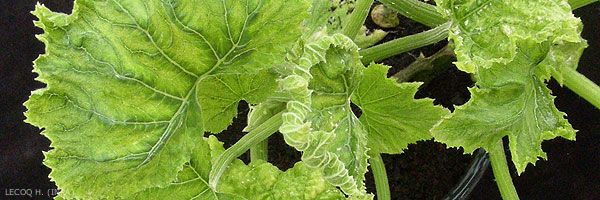
Tomato leaf curl New Delhi virus
(ToLCNDV)
Alert: first report of ToLCNDV in France in September 2020
A new virus disease seriously affecting zucchini was identified and characterized in Spain in 2013, in field crops and under poorly protected shelters located in the regions of Almeria and Murcia (Campo de Cartagena). This is caused by a geminivirus similar to the Tomato yellow leaf curl virus (TYLCV), the Tomato leaf curl new delhi virus (ToLCNDV) (New Delhi virus of the rolled leaves of the tomato).
Symptoms associated with this virus are most evident on young leaves, which curl up, curl up and remain small. The blade shows more or less intense interveinal yellowing (Figures 1 to 5). Fruits can also be affected, showing an intensifying embossing of the epidermis as they grow. Plant growth can be severely slowed down or even completely blocked.
Note that ToLCNDV was also isolated in Spain from samples of cucumber, squash and melon showing the following symptoms: intense yellow mosaic, leaf curl and deformation, and very pronounced stunting and loss of vigor in plants.
This virus, initially geographically confined to the Indian subcontinent, was first described in India in 1995. In recent years, it has been reported in several countries and on various hosts: 2013-Spain-Courgette especially; 2012-India- Luffa cylindrica ; 2012-India- Cucurbita moschata ; 2011-Indonesia-cucumber; 2011-India-tomato; 2007-Taiwan- Cucumis melo var. makuwa (oriental melon); 2006-India- chili; 2005-India- Momordica charantia ; 2004-Pakistan-chili; 2003-India-tomato; 2000-Thailand-cucumber and melon. It appears to be expanding in Asia and China, and possibly the Middle East.
ToLCNDV was detected in several outbreaks in the south of France (PACA region and Occitanie) in September 2020 in zucchini crops. The strains identified in France are closely related to Mediterranean strains, and in particular to those present in Italy and Spain. Reporting this regulated virus involves setting up a national surveillance plan.
We advise you to consult the TYLCV sheet available in the tomato application. A great deal of information concerning its biology and the methods of protection to be implemented should be able to be extrapolated to ToLCNDV, with the exception of the host range which seems much greater for the latter virus. Like TYLCV, ToLCNDV is transmitted by the whitefly Bemisia tabaci circulating and persistent, which should allow this vector to remain viruliferous throughout its life. Note that transmission by seeds has been described for this virus at least on zucchini ( Cucurbita pepo ) although this is subject to debate between scientists and has not been decided today. But if it does occur, we can assume that its impact on epidemics is not essential compared to transmission by whitefly or via plant transport.





